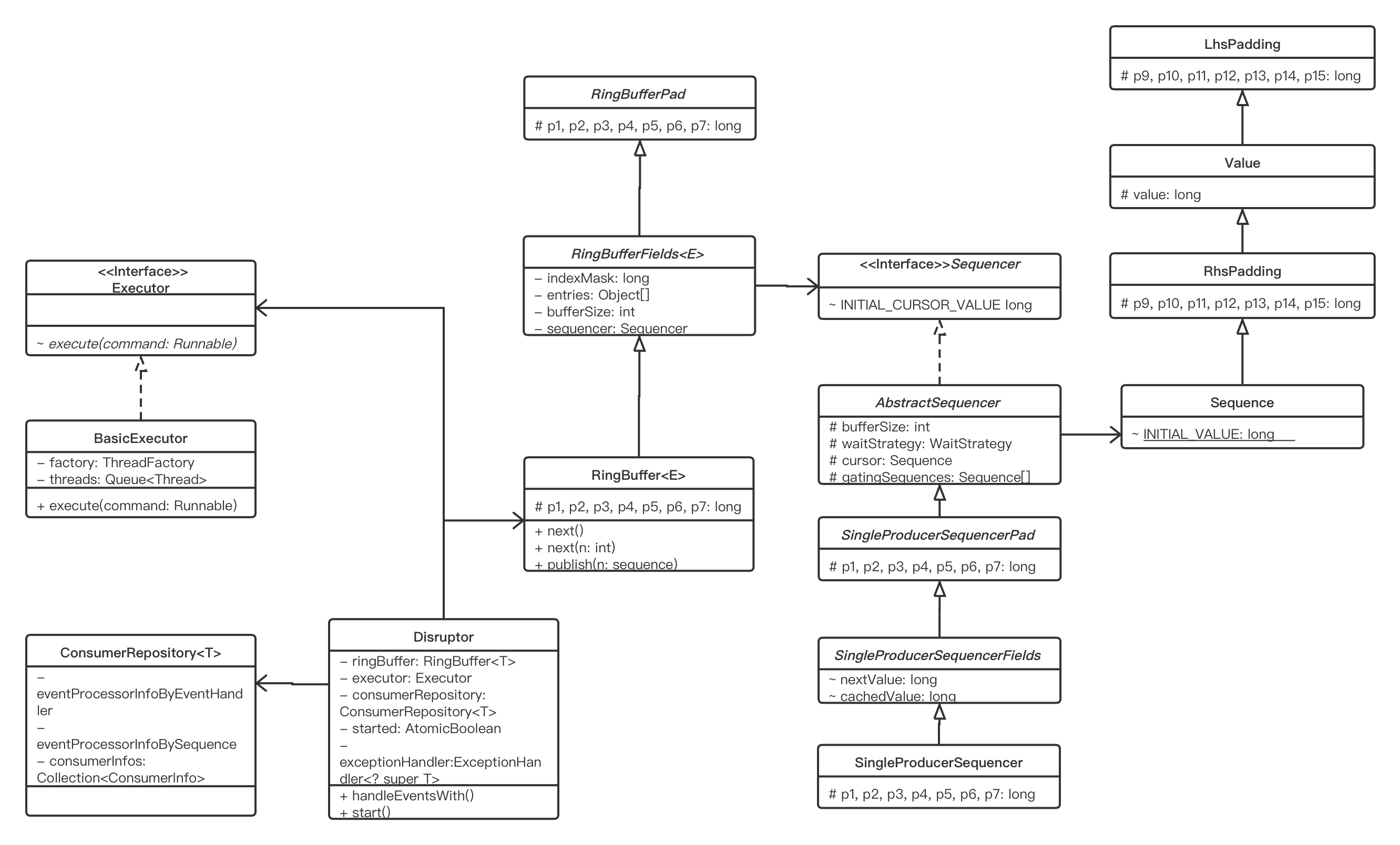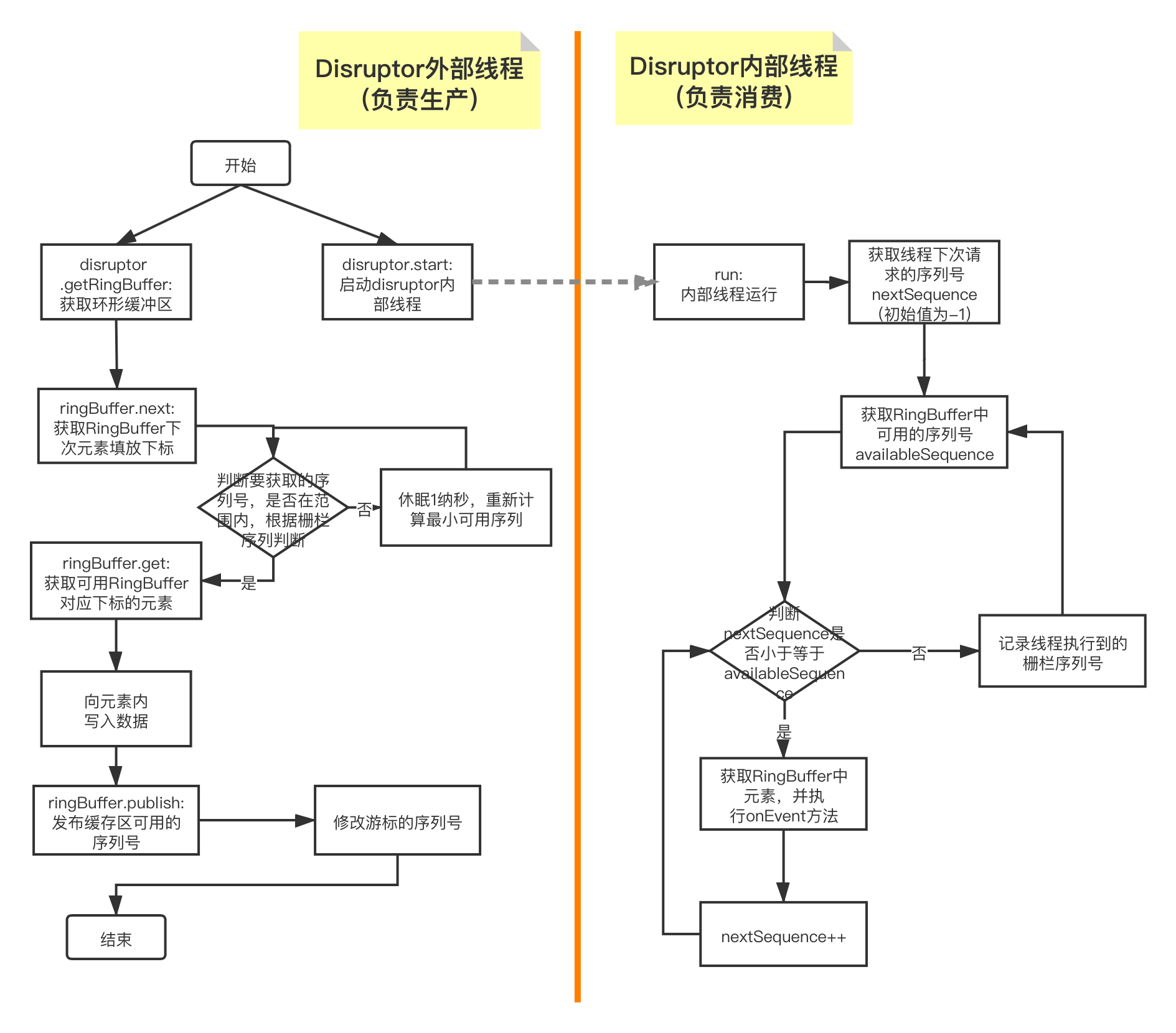Disruptor类图

Disruptor执行过程

Disruptor源码分析

1 // 环形缓冲区 2 private final RingBuffer<T> ringBuffer; 3 // 实现者 4 private final Executor executor; 5 // 消费仓库 6 private final ConsumerRepository<T> consumerRepository = new ConsumerRepository<>(); 7 // 启动标识,原子boolean类,Disruptor只能启动一次 8 private final AtomicBoolean started = new AtomicBoolean(false); 9 // 异常处理器 10 private ExceptionHandler<? super T> exceptionHandler = new ExceptionHandlerWrapper<>(); 11 12 13 14 15 // 主要有3个未过时的构造方法 16 public Disruptor(final EventFactory<T> eventFactory, final int ringBufferSize, final ThreadFactory threadFactory) 17 { 18 this(RingBuffer.createMultiProducer(eventFactory, ringBufferSize), new BasicExecutor(threadFactory)); 19 } 20 21 22 // eventFactory 事件工厂 23 // ringBufferSize 环形缓冲区大小 24 // producerType 生产者类型 25 // waitStrategy 阻塞策略 26 public Disruptor( 27 final EventFactory<T> eventFactory, 28 final int ringBufferSize, 29 final ThreadFactory threadFactory, 30 final ProducerType producerType, 31 final WaitStrategy waitStrategy) 32 { 33 this( 34 RingBuffer.create(producerType, eventFactory, ringBufferSize, waitStrategy), 35 new BasicExecutor(threadFactory)); 36 } 37 38 39 private Disruptor(final RingBuffer<T> ringBuffer, final Executor executor) 40 { 41 this.ringBuffer = ringBuffer; 42 this.executor = executor; 43 } 44 45 46 47 48 49 // 创建环形缓冲区 50 public static <E> RingBuffer<E> create( 51 ProducerType producerType, 52 EventFactory<E> factory, 53 int bufferSize, 54 WaitStrategy waitStrategy) 55 { 56 // 选择对应生产者类型的环形缓冲区创建 57 switch (producerType) 58 { 59 case SINGLE: 60 // 单生产者类型 61 return createSingleProducer(factory, bufferSize, waitStrategy); 62 case MULTI: 63 return createMultiProducer(factory, bufferSize, waitStrategy); 64 default: 65 throw new IllegalStateException(producerType.toString()); 66 } 67 } 68 69 70 // 创建单生产者类型的环形缓冲区 71 public static <E> RingBuffer<E> createSingleProducer( 72 EventFactory<E> factory, 73 int bufferSize, 74 WaitStrategy waitStrategy) 75 { 76 // 77 SingleProducerSequencer sequencer = new SingleProducerSequencer(bufferSize, waitStrategy); 78 79 return new RingBuffer<E>(factory, sequencer); 80 } 81 82 // 构造方法 SingleProducerSequencer 83 public SingleProducerSequencer(int bufferSize, WaitStrategy waitStrategy) 84 { 85 super(bufferSize, waitStrategy); 86 } 87 88 89 // 构造方法 RingBuffer 90 RingBuffer( 91 EventFactory<E> eventFactory, 92 Sequencer sequencer) 93 { 94 super(eventFactory, sequencer); 95 } 96 97 98 99 100 // RingBuffer 的父中存在的静态块 101 bstract class RingBufferFields<E> extends RingBufferPad 102 { 103 // 缓存填充数量,即空白数组长度(看静态代码块理解) 104 private static final int BUFFER_PAD; 105 // 真实存数据数组的内存偏移量(看静态代码块理解) 106 private static final long REF_ARRAY_BASE; 107 // 引用数据类型左移数(看静态代码块理解) 108 private static final int REF_ELEMENT_SHIFT; 109 private static final Unsafe UNSAFE = Util.getUnsafe(); 110 111 static 112 { 113 // UNSAFE.arrayIndexScale 是获取一个数组在内存中的scale, 114 // 也就是每个数组元素在内存中的元素的内存偏移量 115 // 因为我们的event是任意一个对象,所以在这里用一个Object的数组class来求scale 116 final int scale = UNSAFE.arrayIndexScale(Object[].class); 117 // 不同的JVM设置,它的指针大小是不一样的 118 if (4 == scale) 119 { 120 // 计算内存偏移量的常量,数量 << REF_ELEMENT_SHIFT 121 // 例如:int[2],第一个元素的偏移量就是 16 + 0 << 2,第二个 16 + 1 << 2 122 REF_ELEMENT_SHIFT = 2; 123 } 124 else if (8 == scale) 125 { 126 // 例如:long[2],第一个元素的偏移量就是 16 + 0 << 3,第二个 16 + 1 << 3 127 REF_ELEMENT_SHIFT = 3; 128 } 129 else 130 { 131 throw new IllegalStateException("Unknown pointer size"); 132 } 133 // 缓存行是64个字节 134 // 由于数据是保存在数组中的,所以要将数据与其他变量隔开,让数组真实数据与其他变量不在同一个缓存行中 135 // 即:A变量 + 缓存隔离带(128个字节) + 数组真实数据 + 缓存隔离带(128个字节) + B变量 136 // 缓存隔离带使用空数组来代替 137 // 即:A变量 + 空白数组(128个字节) + 数组真实数据 + 空白数组(128个字节) + A变量 138 // 计算:128 / 对象在内存的大小 scale = BUFFER_PAD (即是空白数组的长度) 139 BUFFER_PAD = 128 / scale; 140 // 获取数组在内存中的偏移量,也就是第一个真实数据元素的内存偏移量 141 // 由于数组 是分三部分,空白数组(128个字节) + 数组真实数据 + 空白数组(128个字节) 142 // 那么数组真实数据起始偏移量就是:UNSAFE.arrayBaseOffset(Object[].class) + 空白数组(128个字节) 143 // 空白数据的个数就是 BUFFER_PAD,它向左移 REF_ELEMENT_SHIFT ,得到的就是空白数组的内存偏移量 144 // REF_ARRAY_BASE = (数组对象头 + 空白数组(128个字节)) 145 REF_ARRAY_BASE = UNSAFE.arrayBaseOffset(Object[].class) + (BUFFER_PAD << REF_ELEMENT_SHIFT); 146 147 } 148 149 private final long indexMask; // 索引标识 150 private final Object[] entries;//申明一个对象数组 151 protected final int bufferSize; 152 protected final Sequencer sequencer; 153 154 RingBufferFields( 155 EventFactory<E> eventFactory, 156 Sequencer sequencer) 157 { 158 this.sequencer = sequencer; 159 this.bufferSize = sequencer.getBufferSize(); 160 161 if (bufferSize < 1) 162 { 163 throw new IllegalArgumentException("bufferSize must not be less than 1"); 164 } 165 if (Integer.bitCount(bufferSize) != 1) 166 { 167 throw new IllegalArgumentException("bufferSize must be a power of 2"); 168 } 169 // 索引标识 170 this.indexMask = bufferSize - 1; //indexMask 就是数组的最大下标 171 // 有上静态代码块可知,整个数组是 空白数组(128个字节) + 数组真实数据 + 空白数组(128个字节) 172 // 数据长度就是:BUFFER_PAD + sequencer.getBufferSize() + BUFFER_PAD 173 this.entries = new Object[sequencer.getBufferSize() + 2 * BUFFER_PAD]; 174 // 给正式数据数组,初始化值,使用eventFactory 175 fill(eventFactory); 176 } 177 } 178 179 // 获取sequence下标的元素 180 protected final E elementAt(long sequence) 181 { 182 // 构造方法初始化时:indexMask = bufferSize - 1; 183 // 整个数组是 空白数组(128个字节) + 数组真实数据 + 空白数组(128个字节) 184 // REF_ARRAY_BASE = (数组对象头 + 空白数组(128个字节)) 185 // 根据内存偏移量取获取对应数组元素 186 return (E) UNSAFE.getObject(entries, REF_ARRAY_BASE + ((sequence & indexMask) << REF_ELEMENT_SHIFT)); 187 } 188 189 // 填入生产事件 190 private void fill(EventFactory<E> eventFactory) 191 { 192 for (int i = 0; i < bufferSize; i++) 193 { 194 entries[BUFFER_PAD + i] = eventFactory.newInstance(); 195 } 196 } 197 198 199 // 构造方法 BasicExecutor 200 public BasicExecutor(ThreadFactory factory) 201 { 202 this.factory = factory; 203 } 204 205 206 207 // Disruptor 类中 handleEventsWith() 208 public final EventHandlerGroup<T> handleEventsWith(final EventHandler<? super T>... handlers) 209 { 210 return createEventProcessors(new Sequence[0], handlers); 211 } 212 213 214 // Disruptor 类中 createEventProcessors() 215 EventHandlerGroup<T> createEventProcessors( 216 final Sequence[] barrierSequences, 217 final EventHandler<? super T>[] eventHandlers) 218 { 219 // 检查没有启动 220 checkNotStarted(); 221 222 // 创建处理序列器组 223 final Sequence[] processorSequences = new Sequence[eventHandlers.length]; 224 // 创建序列栅栏 225 final SequenceBarrier barrier = ringBuffer.newBarrier(barrierSequences); 226 227 // 遍历事件处理器,创建对应的批处理事件进程,每个事件一个 228 for (int i = 0, eventHandlersLength = eventHandlers.length; i < eventHandlersLength; i++) 229 { 230 final EventHandler<? super T> eventHandler = eventHandlers[i]; 231 232 // 创建对应的批处理事件进程 233 final BatchEventProcessor<T> batchEventProcessor = 234 new BatchEventProcessor<>(ringBuffer, barrier, eventHandler); 235 236 if (exceptionHandler != null) 237 { 238 batchEventProcessor.setExceptionHandler(exceptionHandler); 239 } 240 241 // 增加消费仓库信息 242 consumerRepository.add(batchEventProcessor, eventHandler, barrier); 243 // 将sequence添加到组中 244 processorSequences[i] = batchEventProcessor.getSequence(); 245 } 246 247 // 248 updateGatingSequencesForNextInChain(barrierSequences, processorSequences); 249 250 return new EventHandlerGroup<>(this, consumerRepository, processorSequences); 251 } 252 253 // 更新栅栏序列信息 254 private void updateGatingSequencesForNextInChain(final Sequence[] barrierSequences, final Sequence[] processorSequences) 255 { 256 if (processorSequences.length > 0) 257 { 258 // 给 ringBuffer 添加 进程中的 栅栏序列信息 259 ringBuffer.addGatingSequences(processorSequences); 260 for (final Sequence barrierSequence : barrierSequences) 261 { 262 // 移除 barrierSequence 263 ringBuffer.removeGatingSequence(barrierSequence); 264 } 265 consumerRepository.unMarkEventProcessorsAsEndOfChain(barrierSequences); 266 } 267 } 268 269 270 271 // 启动RingBuffer 272 public RingBuffer<T> start() 273 { 274 // 启动,检查是否只启动一次 275 checkOnlyStartedOnce(); 276 // 遍历消费者仓库 277 for (final ConsumerInfo consumerInfo : consumerRepository) 278 { 279 // 消费 280 consumerInfo.start(executor); 281 } 282 283 return ringBuffer; 284 } 285 286 287 288 // 启动,并检查是否只启动一次 289 private void checkOnlyStartedOnce() 290 { 291 if (!started.compareAndSet(false, true)) 292 { 293 throw new IllegalStateException("Disruptor.start() must only be called once."); 294 } 295 } 296 297 298 // EventProcessorInfo 类中的 start() 299 @Override 300 public void start(final Executor executor) 301 { 302 // 执行事件处理器 303 executor.execute(eventprocessor); 304 } 305 306 307 308 309 // 执行事件处理器 310 @Override 311 public void execute(Runnable command) 312 { 313 // 使用线程工厂创建了一个线程 314 final Thread thread = factory.newThread(command); 315 if (null == thread) 316 { 317 throw new RuntimeException("Failed to create thread to run: " + command); 318 } 319 320 // 启动线程 321 thread.start(); 322 323 // 添加到线程队列中 324 threads.add(thread); 325 } 326 327 328 // 获取 环形缓冲区 329 public RingBuffer<T> getRingBuffer() 330 { 331 return ringBuffer; 332 } 333 334 335 // 获取序列号为 sequence 的元素 336 public E get(long sequence) 337 { 338 // 获取序列号为 sequence 的元素 339 return elementAt(sequence); 340 } 341 342 343 344 // RingBuffer 类中的 next() 345 public long next() 346 { 347 return sequencer.next(); 348 } 349 350 351 // SingleProducerSequencer 类中的 next() 352 public long next() 353 { 354 return next(1); 355 } 356 357 358 // 获取下一个Sequencer 序列号 359 public long next(int n) 360 { 361 if (n < 1) 362 { 363 throw new IllegalArgumentException("n must be > 0"); 364 } 365 366 // 取出 Sequencer 记录的 上一次返回序列号nextValue 367 long nextValue = this.nextValue; 368 // 根据要取出数量n,计算下标nextSequence值 369 long nextSequence = nextValue + n; 370 // 超过缓存大小的差值 371 long wrapPoint = nextSequence - bufferSize; 372 // 缓存值大门值 373 long cachedGatingSequence = this.cachedValue; 374 // 判断超过缓存大小的差值 是否大于 大门值 或者 大门值 > nextValue 375 if (wrapPoint > cachedGatingSequence || cachedGatingSequence > nextValue) 376 { 377 // CAS设置了游标的值 378 // 加入了StoreLoad屏障,保证写入都,其他线程可见 379 cursor.setVolatile(nextValue); // StoreLoad fence 380 // 最小顺序值 381 long minSequence; 382 // 判断超过缓存大小的差值 是否大于 最小的序号 383 while (wrapPoint > (minSequence = Util.getMinimumSequence(gatingSequences, nextValue))) 384 { 385 // 休眠1纳秒 386 LockSupport.parkNanos(1L); // TODO: Use waitStrategy to spin? 387 } 388 // 最小的序号 赋值给 缓存值 389 this.cachedValue = minSequence; 390 } 391 // 记录返回序列号 392 this.nextValue = nextSequence; 393 394 return nextSequence; 395 } 396 397 398 399 400 // 发布 401 public void publish(long sequence) 402 { 403 // 设置游标序号 404 cursor.set(sequence); 405 // 通知所有阻塞线程 406 waitStrategy.signalAllWhenBlocking(); 407 } 408 409 410 411 // 运行 412 public void run() 413 { 414 // 判断线程运行状态 415 if (!running.compareAndSet(IDLE, RUNNING)) 416 { 417 if (running.get() == RUNNING) 418 { 419 throw new IllegalStateException("Thread is already running"); 420 } 421 } 422 // 序列号屏障情况告警 423 sequenceBarrier.clearAlert(); 424 425 // 通知开启 426 notifyStart(); 427 428 try 429 { 430 // 判断线程是否处于暂停状态 431 if (running.get() == HALTED) 432 { 433 return; 434 } 435 436 T event = null; 437 // 下一个序列号 438 long nextSequence = sequence.get() + 1L; 439 440 while (true) 441 { 442 try 443 { 444 // 获取可用的序列号--无法获取到,在其中等待 445 final long availableSequence = sequenceBarrier.waitFor(nextSequence); 446 if (batchStartAware != null) 447 { 448 batchStartAware.onBatchStart(availableSequence - nextSequence + 1); 449 } 450 451 // 下一个序列号 <= 获取可用的序列号 452 while (nextSequence <= availableSequence) 453 { 454 // 获取对应的元素 455 event = dataProvider.get(nextSequence); 456 // 调用onEvent() 处理事件元素 457 eventHandler.onEvent(event, nextSequence, nextSequence == availableSequence); 458 nextSequence++; 459 } 460 // 直到 下一个序列号 > 获取可用的序列号 461 // 记录 序列号到达的位置 462 sequence.set(availableSequence); 463 } 464 catch (final TimeoutException e) 465 { 466 notifyTimeout(sequence.get()); 467 } 468 catch (final AlertException ex) 469 { 470 if (running.get() != RUNNING) 471 { 472 break; 473 } 474 } 475 catch (final Throwable ex) 476 { 477 exceptionHandler.handleEventException(ex, nextSequence, event); 478 sequence.set(nextSequence); 479 nextSequence++; 480 } 481 } 482 } 483 finally 484 { 485 // 通知关闭 486 notifyShutdown(); 487 // 设置线程状态 488 running.set(IDLE); 489 } 490 } 491 492 493 494 495 public void clearAlert() 496 { 497 alerted = false; 498 } 499 500 501 502 503 // ProcessingSequenceBarrier 中的waitFor() 504 public long waitFor(final long sequence) 505 throws AlertException, InterruptedException, TimeoutException 506 { 507 // 检查告警,如果告警直接报异常 508 // disruptor调用停止方法时,alert为true,则会告警 509 checkAlert(); 510 511 // 获取可用的序列号 512 long availableSequence = waitStrategy.waitFor(sequence, cursorSequence, dependentSequence, this); 513 514 // 判断可用序列号 是否小于 请求序列号 515 if (availableSequence < sequence) 516 { 517 return availableSequence; 518 } 519 520 // 返回最高可用的序列号,即是 availableSequence 521 return sequencer.getHighestPublishedSequence(sequence, availableSequence); 522 } 523 524 // BlockingWaitStrategy 中的 waitFor() 525 public long waitFor(long sequence, Sequence cursorSequence, Sequence dependentSequence, SequenceBarrier barrier) 526 throws AlertException, InterruptedException 527 { 528 long availableSequence; 529 // 判断游标中的序列号,是否小于 请求的序列号 530 if (cursorSequence.get() < sequence) 531 { 532 // 加锁 533 lock.lock(); 534 try 535 { 536 // 判断游标中的序列号,是否小于 请求的序列号 537 while (cursorSequence.get() < sequence) 538 { 539 // 检查告警, disruptor调用停止方法时会告警 540 barrier.checkAlert(); 541 // 线程条件等待 542 processorNotifyCondition.await(); 543 } 544 } 545 finally 546 { 547 // 解锁 548 lock.unlock(); 549 } 550 } 551 552 // 从依赖的序列器中获取 可用的序列号 553 while ((availableSequence = dependentSequence.get()) < sequence) 554 { 555 556 barrier.checkAlert(); 557 ThreadHints.onSpinWait(); 558 } 559 560 return availableSequence; 561 }
